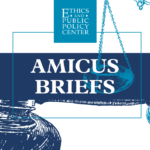Published October 31, 2011
It's been a bad three and a half decades for self-styled “progressive” Catholics.
First, there was John Paul II, whom many in that camp habitually labeled a charismatic reactionary. Yet the Polish pope was a hero all over the world during an epic pontificate that bent history's arc in a more humane direction, and did so without the aid of liberation theology. John Paul's funeral Mass on April 8, 2005, became, in the apt phrase of NBC anchor Brian Williams, “the human event of a generation,” a moniker unlikely to be attached to the obsequies of, say, Hans Küng, John Paul's most embittered progressive critic.
Then came the election of the progressives' bête noire, Joseph Ratzinger, as Pope Benedict XVI: a horror that a prominent progressive, Notre Dame's Fr. Richard McBrien, declared electorally impossible a mere 24 hours before it happened. Catholic progressives hunkered down for what they hoped would be a brief Ratzingerian interregnum. But Benedict XVI has proven an energetic pope whose pontificate has been in dynamic continuity with that of his predecessor, an astute analyst of the cultural crisis of the West, and a man determined to strengthen Catholic identity as the sine qua non of Catholic reform.
Thus the Wojtyla-Ratzinger years have put paid to the notion, beloved of Catholic progressives, that Catholicism began anew –ex nihilo, as it were – at the Second Vatican Council. Committed to the hoary “liberal/conservative” hermeneutic of the Council's history, Catholic progressives hold that Vatican II represented a dramatic rupture with the past. The great teaching pontificates of John Paul II and Benedict XVI, however, have proposed a far more plausible interpretation of the Council as one in dynamic continuity with the great tradition of Christian orthodoxy. That interpretation, in turn, is shaping an entire new generation of Catholic intellectuals who are far more interested in exploring the complex riches of that tradition than in deconstructing it. Unlike the aging progressives, who have shown themselves rather infertile intellectually and who survive in large part because of that most conservative of institutions, the tenure system, many younger Catholic scholars are fully committed to putting theology at the service of the “New Evangelization” for which John Paul II and Benedict XVI have insistently called.
In the United States, the progressives have also been steadily losing their grip at the national, diocesan, and local-parish levels. Various lay-renewal movements have become vital and self-consciously orthodox factors in Catholic life, and a new generation of priests and bishops, many of whom look explicitly to John Paul II as their model of ecclesiastical leadership, have come to the fore. For the past half-decade or more, the Catholic bishops of the United States, following the pope's lead, have increasingly stressed the importance of Catholic identity, by which they understand fidelity to Catholic teaching, in confronting an increasingly hostile cultural and legal/political environment. That problem has been considerably exacerbated by the Obama administration, which many Catholic progressives welcomed with loud hosannas, and for whose regulatory assault on Catholic health-care and social-service agencies progressives have provided cover, often by implausible appeals to Catholic social doctrine.
Throughout this fairly rapid decline, progressive Catholicism's distinctive cultural marker has been its skepticism about the teaching authority of the Church: whether that teaching authority was formally and authoritatively addressing the ethics of human love, the suitability of women for Holy Orders, the uniqueness of Christ as universal savior, or the intrinsic evils of abortion and euthanasia. Thus it was another sign of the increasing incoherence of progressive Catholicism when several of its American paladins mounted a raucous defense of a “Note” – a kind of Vatican white paper – on international financial reform issued by the Pontifical Council for Justice and Peace (PCJP) on October 24. It was an extraordinary exercise: The progressives depicted Benedict XVI as a senior chaplain to Occupy Wall Street, described the Note in such overwrought terms that the gullible might have thought this white paper shared in the charism of papal infallibility, and darkly suggested that those who disagreed with the Note's prescriptions were cafeteria Catholics, picking and choosing their doctrines to fit preexisting political tastes.
The irony of men such as the former editor of America, Fr. Thomas Reese, S.J.,Washington Post columnist E. J. Dionne Jr., and National Catholic Reporter blogger Michael Sean Winters promoting a notion of papal teaching authority more expansive than any imagined by the most wild-eyed traditionalist will not be lost on cognoscenti of ecclesiastical intrigue. This new notion of PCJP infallibility does, however, raise interesting questions – about the nature and modalities of Catholic teaching authority, about the organization of the Holy See, and about the state of Catholic progressivism in America.
Given the continuing confusion caused by Father Reese's assertion that the Note positioned Benedict XVI “to the left of Nancy Pelosi” (which reverberated throughout the media echo chamber), it's important to pin down just what the Pontifical Council for Justice and Peace is, and what authority its statements bear.
The Pontifical Council (with whose president, Cardinal Peter Turkson, I had an entirely cordial 90-minute conversation last year) was established after Vatican II as part of the “New Curia,” a set of agencies intended to give organizational expression to some of Vatican II's pastoral concerns: the promotion of social doctrine, the family, the lay mission in the world, and so forth. Unlike the older Congregations of the Roman Curia, which exercise an authority of jurisdiction (over bishops, clergy, religious life, Catholic worship, etc.), and unlike the Tribunals of the Curia, which make binding legal decisions, the “Pontifical Councils” of the New Curia were intended to be in-house think-tanks. Bureaucracy being what it is, however, they quickly morphed into something else: paper factories issuing all sorts of statements on all sorts of issues. As I wrote in God's Choice: Pope Benedict XVI and the Future of the Catholic Church, there was concern during the 2005 conclave over the large amount of paper being generated by the New Curia: paper that was inevitably, if inaccurately, interpreted publicly as being the settled understanding of the Catholic Church and its highest teaching authority on X, Y, and Z.
Official Church documents make clear that this is not the case. The Pontifical Councils of the New Curia are intended to support the mission of the pope as universal pastor of the Church; but they do not share in his teaching authority. The Church's principal doctrinal agency, the Congregation for the Doctrine of the Faith, in the 1990 instruction Donum Veritatis (The Gift of Truth),put the matter quite clearly: “The Roman Pontiff fulfills his universal mission with the help of the various bodies of the Roman Curia and in particular with that of the Congregation for the Doctrine of the Faith in matters of doctrine and morals. Consequently, the documents issued by this Congregation expressly approved by the Pope participate in the ordinary magisterium of the successor of Peter.” That statement, which is made of no other entity in the Roman Curia, is then substantiated by reference to the Code of Canon Law and the Apostolic Constitutions of Paul VI and John Paul II on the structure of the Roman Curia.
It is simply wrong, then, to say that a Note like that from the Pontifical Council on Justice and Peace is somehow a matter of “the pope says” or “the Vatican says” or “the Catholic Church teaches.” It is inconceivable that Father Reese does not know this, and it is very unlikely that Mr. Winters
does not know this. Since Donum Veritatis and the Code of Canon Law cannot be blamed on the George W. Bush administration, it's unclear whether Dr. Dionne knows this. In any event, the suggestion from progressive Catholic circles that the PCJP Note on international finance was an expression of the teaching authority of the Church can be dismissed as ill-informed, disingenuous, deeply confused – or all of the above.
It is also, true, however, that the current managerial dysfunction in the Vatican contributes to this mischief making. The world assumes that a statement released by a Vatican agency at a press conference in the Vatican must have been thoroughly vetted throughout the various layers of the Curia. But that in fact cannot be assumed, and in the case of the Justice and Peace Note it should not be assumed. The empirical analysis in the Note stands or falls on its own merits. The Note's prescriptions should be judged both on their prudential merit (can and should these things be done?) and on their coherence with the core principles of Catholic social doctrine (do these prescriptions make Catholic sense?). Those whose answers tend toward the negative ought not be caricatured as market idolaters or cafeteria Catholics.
As for the future, while a conclave cannot bind the pope it elects to any particular action, it seems likely that the kind of confusion that ensued after the PCJP Note will lead to a future conclave suggesting that the man it elects take a hard look at the New Curia, with an eye to reconstructing offices such as the PCJP as the in-house think-tanks for the pope and the senior Curia that they were originally intended to be.
After the last papal election, one wit, referring to gape-mouthed progressives who had convinced themselves that This Just Couldn't Happen, observed that the senior cardinal deacon, announcing the election to Rome and the world, should have said that the new pope was Joseph Ratzinger, “qui sibi nomen imposuit [who has taken the name] Your Worst Nightmare.” That those who thought the worst had come (some of whom had spent the weeks between John Paul's death and Benedict's election doing everything possible to prevent a Ratzinger victory) should now position themselves as the defenders of Benedict's teaching authority strains irony into the gravest implausibility. That these same defenders, presenting themselves as close students of Catholic social doctrine, should propose something as ridiculous as the notion that this deeply learned pope (who in his address to public life has consistently proposed the urgency of linking civil law to the moral law that we can know by reason) is sympathetic to the madcap anarchists of Occupy Wall Street tells us something about the desperation in progressive Catholic circles these days.
Why the desperation? The progressives are losing; they know it, at some level; and because the idea of losing is inconceivable to those who have long imagined themselves on the right side of both political and ecclesiastical history, they tell themselves, and the rest of us, increasingly bizarre tales, like Lewis Carroll's White Queen teaching herself impossible things before breakfast. Ratzinger-as-Chaplain-to-OWS is thus a kind of desperate grasping for relevance at a moment of increasing progressivist irrelevance. They have lost inside the Church: The men and women in the growing religious orders, the men in the growing seminaries, the active younger laity, all look on progressive Catholicism as a kind of weird phenomenon of their parents' generation. And now they are losing publicly. Progressive Catholicism in America bet the farm on Barack Obama, and, as progressive Catholics begin to sense with horror that the administration is a train wreck about to happen, we may yet see even stranger tales told than that of Benedict the Left-Wing Activist.
Thomas Merton sensed the inherent implausibility of progressive Catholicism in the mid-1960s – despite his support of the civil-rights, anti-nuclear, and anti-Vietnam movements. In his student days at Columbia, Merton had known real Communists, and he wasn't much impressed with the juvenile leftism that swamped the Church in the wake of Vatican II. Merton put the complaint about progressive Catholicism and its furies about as well as it can be put in one of the “nonsense letters” he wrote to his old friend, the poet Robert Lax: “I am truly spry and full of fun, but am pursued by the vilifications of progressed Catholics. Mark my word man there is no uglier species on the face of the earth than progressed Catholics, mean, frivol, ungainly, inarticulate, venomous, and bursting at the seams with progress into the secular cities and Teilhardian subways. The Ottavianis was bad but these are infinitely worse. You wait and see.”
The Church and the world have waited for almost a half-century. Now those with eyes to see have seen. But as weird as Pope Benedict the Wall Street Occupier may seem, stranger things could yet come, as the incoherences multiply and the vitriol follows suit.
– George Weigel is distinguished senior fellow of Washington's Ethics and Public Policy Center, where he holds the William E. Simon Chair in Catholic Studies.








